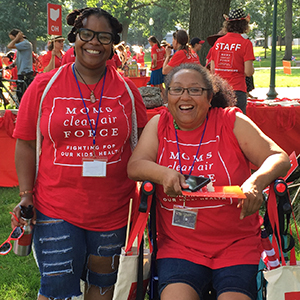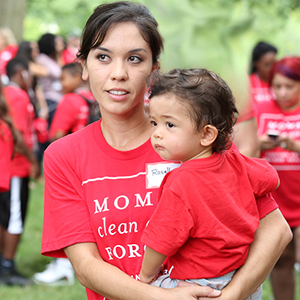This resource has been factchecked by policy experts, using the latest scientific research. Find all our sources linked below.
Heat waves supercharged by devastating global warming routinely cause hundreds of deaths worldwide—over 600 in an Arizona summer alone. Heat is now the leading cause of weather-related deaths in the U.S. This is the direct result of pollution from power plants, cars, trucks, buses, and other human activities. The gases that get released when fossil fuels are burned have made the Earth hotter. As a result, days of extreme heat are more frequent and intense, and heat waves last longer.
Today’s warmer than average temperatures aren’t only deadly; extreme weather chaos also triggers heat-related illnesses and makes existing health problems worse. Heat can also make air pollution worse, combining with chemicals in the air to create ozone, or smog. And extreme heat is interrupting how we live, shifting when it’s safe to work and play outside and requiring families to take precautions to protect kids from scorching playground equipment.
Here’s what you need to know about safeguarding health in times of intense heat.

Extreme heat can harm our health in a variety of ways:
Direct health harms from heat
Extreme heat-related illnesses can range from mild to life-threatening. Heat waves have been linked to higher rates of hospitalization for cardiovascular, kidney, respiratory, and mental health disorders.
While temperature-induced conditions like heat stroke are fairly well known, extreme heat has also been linked to a wide variety of other concerns, including adverse birth outcomes.
Exposure to high heat during pregnancy may increase the risk of complications, including preterm birth, low birth weight, pregnancy loss, and heat-related stress in newborn babies.
High temperatures can also interfere with body temperature regulation. When bodies can’t cool off, the heart works harder to regulate temperature, which can cause excessive strain on organs. Higher nighttime temperatures can also interfere with sleep, which can exacerbate other health issues.
Indirect health harms from heat
Extreme heat can harm health even if it doesn’t make you ill because it frequently results in increased ambulance calls and hospitalizations, which can disrupt health services. Also, medicines that need to be stored at moderate temperatures can be rendered ineffective and possibly unsafe by extreme temperatures.
Prolonged periods of extreme heat can create heavy demands for air conditioning, straining power grids and leading to power outages. There are many possible health impacts of power outages including incapacity to cool off plus increased risk of food spoilage, which can lead to food-borne illness.

Know the signs of heat-related illness
Familiarizing yourself with basic symptoms and precautions to take is a smart preventative measure and can even be lifesaving.
Heatstroke is a serious, life-threatening illness that requires immediate medical attention.
Symptoms: Very high body temperature (103°F or higher); hot, red, dry skin; fast, strong pulse; headache; or nausea.
What to do: Call 911 right away. If you are aiding someone suffering from heatstroke, move the person to a cooler place. Use cool cloths or a cool bath to lower their temperature. Do not give the person anything to drink.
Heat exhaustion is milder than heatstroke, but still a serious condition that requires timely care.
Symptoms: Heavy sweating; cold, pale, and clammy skin; fast, weak pulse; nausea or vomiting; muscle cramps; tiredness or weakness; dizziness or blurred vision; headache; or fainting.
What to do: Move to a cooler place. Loosen or remove excess clothing. Put cool, wet cloths on your body or take a cool bath. Sip water. Get immediate medical help if throwing up or symptoms worsen or last longer than one hour.
Heat cramps are painful muscle spasms that typically occur during intense physical activity in hot environments.
Symptoms: Heavy sweating during intense exercise or muscle pain or spasms in the legs, arms, abdominal wall, and back.
What to do: Stop activity and move to a cooler place. Remove excess clothing. Drink water or a sports beverage. Get urgent medical help if cramps last longer than one hour, you’re on a low-sodium diet, or you have heart problems.

Extreme temperatures and communities of color
Places across the United States with large Black populations experience higher temperatures on average, making those communities uniquely vulnerable to extreme heat. They are more likely to live in areas with high levels of air pollution, which, combined with extreme heat, is especially dangerous for people with underlying respiratory and heart problems. This is particularly true in urban settings crowded with buildings, full of heat-absorbing concrete, and without cooling vegetation like trees and green spaces.
Other groups sensitive to heat include babies, children, pregnant people, and older people, as well as outdoor workers, such as first responders and landscaping, construction, and predominately Latino farmworkers, not to mention athletes and outdoor enthusiasts. Members of economically disadvantaged communities are at additional risk as they may have limited access to air-conditioned spaces and health care.

Get involved
Extreme heat kills more people in the U.S. than hurricanes, tornadoes, and floods each year. We need the strongest possible climate policies to help keep our families and communities safe from catastrophic rising temperatures. Join Moms Clean Air Force to demand your lawmakers support laws and regulations that reduce the greenhouse gas pollution causing global warming and extreme heat.
Learn more about Moms’ work on extreme weather.
Full list of sources.
Updated: August 2025




